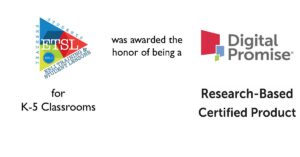“May you find benefit in this story of the evolution of an educator and her practices, told with refreshing honesty and vulnerability. Lindsay Journo, the author of this guest blog, shares the ups and downs of her literacy learning, including what happened once she (reluctantly) discovered EBLI. You also won’t want to miss the companion webinar, which includes a panel with Lindsay and two other educators. Lindsay has a unique perspective from a variety of experiences as an educator: administrator, teacher, trainer, literacy coach, and more.”
– Nora Chahbazi
The following guest blog is written by Literacy Specialist, Lindsay Journo (pictured here):
If the video below isn’t showing – click HERE to view in YouTube.

My EBLI journey began one evening around 18 months ago, when I should have been asleep but instead was scrolling through my favorite Science of Reading Facebook page. For the first time, I saw posts about Structured Linguistic Literacy (aka the “speech-to-print” approach). “This makes no sense,” I declared to my computer screen. “It can’t be right.”
Why was my first reaction so negative? Looking back, I think my feelings stemmed from the journey I’d been on, a journey that might look a lot like yours.
My college teacher prep courses had been steeped in Balanced Literacy, which left me totally unprepared to help the struggling readers and writers in my class. So, I had set out on my own to learn. I read books, listened to podcasts, joined email lists. I trained in the Barton Reading and Spelling Program. I completed a year-long certification in Orton-Gillingham. After spending considerable time, money, and effort across decades, I had morphed into a fully-fledged Science of Reading nerd, and I was proud of my hard-won knowledge.
That’s why, when I read those posts suggesting that some of my conclusions weren’t quite right, or that some of my instructional practices weren’t that effective, I felt angry and defensive. And, honestly, kind of exhausted. I sort of wished I could un-see what I’d seen.
In time, a more reasonable inner voice won out. I knew that I owed it to my students to follow the science. So, shouldn’t I approach this new information as a scientist would – with curiosity and an openness to new evidence?
Rather than ignoring what I’d seen, I decided to register for yet another structured literacy training. I completed my EBLI certification, implemented it with 1-on-1 intervention students, and then began piloting it with elementary teachers at my network of Montessori schools.
My reservations did not disappear overnight. Far from it! Well into my training course, I peppered the (very patient) EBLI team with questions by webinar chat, email, and phone. At the same time, I committed to implementing EBLI with fidelity, and I began to see results.
A 6-year-old with a family history of dyslexia, who had been retained in kindergarten due to lack of progress, started to soar – until her reading scores surpassed the 90th percentile. A 3rd grader, whose poor letter formation and inaccurate spelling made his writing illegible, began to spell words like “centennial” correctly on his first try, and received an award from his teacher for “Best Handwriting”. A 2nd grader who couldn’t make sense of simple decodable books because she guessed wildly at words, now read the novel Castle in the Attic with fluency, accuracy, and understanding.
What struck me most about my students’ progress was the speed: It took months, not years. I’m beginning to understand why. Although I can’t recount all my “aha moments” here, I hope it’s helpful to share two of my strongest early objections about EBLI’s content and structure, and what I’ve learned along the way.
My initial objection: EBLI lacks critical content, particularly the rules for spelling, syllable types, and syllable division. Without this explicit teaching, my students won’t learn to read or spell.
My new understanding: That content is unnecessary. Those spelling and syllabification rules are inconsistent and can impede, rather than bolster, progress[1]. Because they aren’t helpful or reliable tools, they don’t warrant our precious instructional time. Memorizing those rules also requires a huge cognitive load, which is especially problematic for many emerging readers who struggle with working memory and attention. To be effective, our instructional strategies must lighten — not overburden — their cognitive load[2].
So, what replaced this explicit teaching of rules when I switched to EBLI?
A focus on process, specifically a precise and consistent “sounds first” process. My instructional time is now spent modeling, providing worked examples, and offering immediate correction. When spelling, my students learn how to divide syllables as they are naturally spoken, then crisply segment each sound in each syllable. They map letters onto those sounds, always “saying the sounds as they write” because it guides them to accuracy and strengthens neural pathways. I highlight spelling patterns (patterns, not rules) only if they are reliable ones, such as ‘c’ representing the sound /s/ when followed by ‘e’, ‘i’, or ‘y’.
My initial objection: The way EBLI introduces multiple spellings all at once is too much. It will confuse and overwhelm students.
My new understanding: Far from confusing my students, they take it in stride — even those with diagnosed reading challenges. In truth, it was my adult brain that was confused, because I was so used to following a print-to-speech sequence based on the 170+ spellings in English.
EBLI provides a much simpler schema: the 44 sounds in English. The nature of this sound-based code is made clear to students. Once they progress through the 1-to-1 sound/letter correspondences, they learn that 1, 2, 3, or 4 letters can spell a sound, that the same sound can have many spellings, and that the same spelling can represent many sounds.
I expected a big reaction when I began teaching this way, but my students found it unremarkable. By the time we’d proceeded systematically through several sounds, it became par for the course. Yep, sure, the sound /oa/ can be represented by ‘oa’, ‘ow’, or ‘o’ (and even more spellings, if they were older). No biggie.
That clarity contrasted with the confusions and over-generalizations I’d seen in the past. I remember a 1st grader (who had been taught by a print-to-speech method) arguing with me that “boat” couldn’t possibly contain the sound /oa/, because it didn’t have a “magic e”.
My students now trusted the code because they knew what to expect. When reading authentic text, they began to flex among the vowel sound options we’d explored. This skill in “set for variability”[3] improved their reading accuracy and fluency.
I think my “too much at once” fear also stemmed from misconceptions about learning. As an educator, I was used to introducing a concept, practicing it, assessing it, and moving on. While that kind of “stacked practice” feels effective in the moment (Yep! They’ve got it!), the information is lost once short-term memory fades. [4] (So that’s why my students didn’t retain those darn spelling rules!)
In time, I came to see the power of EBLI’s “spaced practice” and “interleaving”[5]. I began to relax because I knew that the introductory activity on the various spellings for /oa/ was just that – an introduction. The children didn’t need to “master it” before moving on. That sound and its spellings would appear again and again, both in our Scope and Sequence and, more importantly, in their own reading and writing. With repeated exposure, applied practice and immediate correction over time, the knowledge would transfer to long-term memory. And that’s real learning.
I know that we all want to help children reach their highest potential. I’ve come to see that EBLI offers a more effective and efficient way to achieve that aim. I hope it was helpful to read about my journey, and I wish you the very best on yours. Know that it’s okay to have questions and reservations along the way. It’s natural to feel uncomfortable when trying something new. Just stay curious and keep learning. You’ll be setting a great example for all the children in your life!
Lindsay Journo is a Literacy Specialist at Guidepost Montessori, a network of schools with over 100 locations across the United States. Over the past 25 years, Lindsay has worked in numerous educational roles, including teacher, interventionist, curriculum director, instructional coach, principal, and teacher trainer. Throughout it all, literacy has remained Lindsay’s passion. In addition to her ELA teaching credential and her AMI early childhood diploma, she is certified in Orton-Gillingham and EBLI. Lindsay is thrilled to be a fellow traveler in support of EBLI’s mission to teach the world to read!
[1] See, for example, David Kearns’ “Does English Have Useful Syllable Division Patterns?”
[2] Find out more in Greg Ashman’s A Little Guide for Teachers: Cognitive Load Theory
[3] See, for example, Marni Ginsberg’s “Set for Variability: A Reading Strategy you may be Overlooking, but Shouldn’t”
[4] I highly recommend Peter C. Brown’s Make It Stick: The Science of Successful Learning
[5] Ibid





